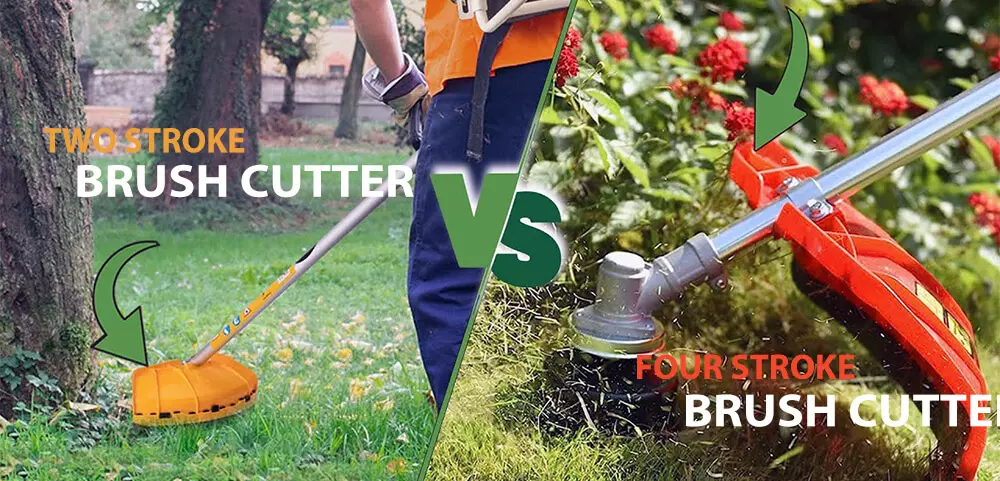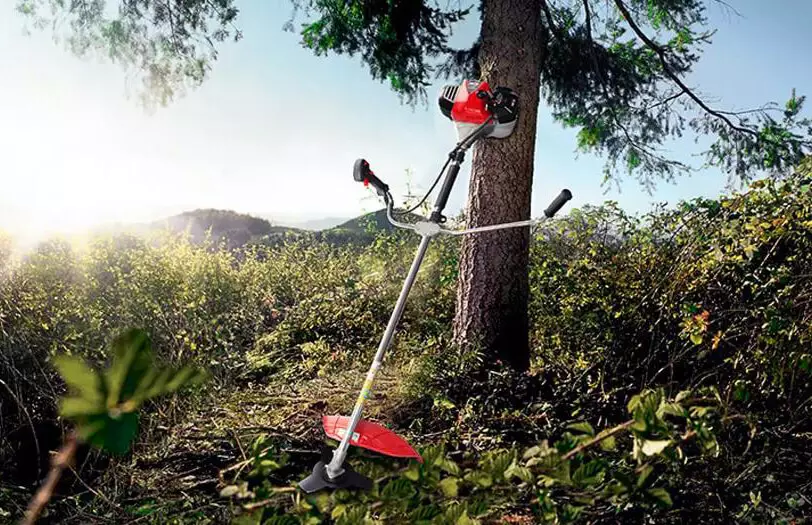08Nov 2023
table of contents

Are you tired of spending hours dealing with your overgrown yard, stubborn weeds, and unruly leaves? BISON brush cutters are the best choice to revolutionize your gardening experience. With their exceptional power, versatility and best-in-class performance, BISON brush cutter is the tool of choice for completing tough mowing tasks with ease.
When choosing right brush cutter, one of the key decisions is whether to choose a two-stroke or four-stroke engine. In this blog post, BISON will give you an understanding of the working principles of these two brush cutters and detailed compare them from all aspects. After reading this article, you will have a clear understanding of which option is better suited for your import needs.
Four-stroke brush cutters operate on a four-stroke combustion cycle, similar to most gasoline engines.It has intake, compression, combustion, and exhaust four stages process comprises. Let's know how it works:
Intake: The intake stroke draws a mixture of fuel and air into the cylinder through the intake valve.
Compression: The piston moves upward to compress the oil-air mixture in the cylinder.
Combustion: At the top of the compression stroke, a spark plug ignites the compressed mixture, causing a controlled explosion. Powerful explosion propelling the piston downwards and generating significant power.
Exhaust: When the piston reaches the bottom of its stroke, exhaust gases are exhausted through the exhaust valve.
Unlike two-stroke brush cutters, four-stroke machines separate the intake and exhaust processes, resulting in more efficient and cleaner combustion.
Two-stroke brush cutters have a simpler, more compact design. It requires only two strokes to complete the combustion process, hence the name. Here is a simplified operation explanation:
Combustion/Power Stroke: The piston moves down from the top of the cylinder, compressing the air-fuel mixture. When it reaches the bottom, the spark plug ignites the mixture, causing an explosion. This explosion provides the force that drives the piston upward.
Exhaust/Intake Stroke: the piston ascends, expelling spent exhaust gases and simultaneously inhaling a potent blend of fuel and air.
Two stroke brush cutters do not have separate inlet and exhaust valves like four stroke brush cutters, which simplifies the design but results in less efficient fuel consumption and emissions.
When considering brush cutters, it's crucial to weigh the advantages and disadvantages of both brsuh cutter types.Therefore, let's explore them from different perspectives.

One of the main differences between two stroke and four stroke brush cutter is their weight. Generally speaking, two stroke brush cutters tend to be lighter than four stroke brush cutters. This is because two stroke engines are simpler in design and have fewer parts, making 2 stroke brush cutter more compact and lightweight. Four stroke brush cutters, on the other hand, are typically heavier because they have additional components such as valves, camshafts, and oil systems.
In terms of horsepower, four-stroke brush cutter has the advantage. Four-stroke engines are designed to deliver power more efficiently, resulting in higher horsepower. This means the four-stroke brush cutter can tackle tougher vegetation and larger areas more easily, making it suitable for heavy-duty cutting tasks. In comparison, a two-stroke brush cutter may have less horsepower and may have difficulty handling tougher vegetation or larger areas.
When it comes to fuel efficiency, four-stroke brush cutter has the edge. Four stroke engines tend to be more fuel efficient than two stroke engines due to a more complex combustion cycle and separate intake and exhaust processes. Four stroke brush cutters consume fuel at a slower rate, which results in longer run time per tank. Two stroke brush cutters, while simpler in design, tend to consume more fuel due to their combined intake and exhaust processes.
When it comes to user comfort, four-stroke brush cutter has the edge. They tend to produce less noise and vibration than two-stroke models. The reduction in vibration makes the machine more comfortable to operate over longer periods of time, reducing user fatigue. Additionally, four-stroke engines produce fewer emissions than two-stroke brush cutters, resulting in cleaner operation and less odor.
One of the significant differences between two-stroke and four-stroke brush cutters is the type of fuel required. Two stroke engines require a specific ratio of gasoline and oil mixture (usually 50:1 or 40:1). This means you need to mix the oil with the fuel before you refuel your brush cutter. Four-stroke brush cutters, on the other hand, use regular gasoline and do not require an oil blend. This makes the refueling process simpler and more convenient for users.
Price is another factor to consider when comparing 2 stroke and 4 stroke brush cutters. Generally, the upfront cost of a two stroke brush cutter is less expensive than a four stroke brush cutter. Two stroke engines are simpler in design, have fewer parts, and are therefore cheaper. However, it's worth noting that four stroke brush cutters may offer long-term cost savings due to their greater fuel efficiency and potentially lower maintenance requirements. Know more about BISON brush cutter price!

In summary, choosing between a 2-stroke and 4-stroke brush cutter depends on a variety of factors. If weight, economy and simplicity are priorities, a two-stroke brush cutter may be suitable. However, if higher horsepower, fuel efficiency, user comfort, reduced emissions, and ease of refueling are important, then a four-stroke brush cutter would be the better choice.
To sum up, when comparing the differences between two-stroke and four-stroke brush cutters in terms of weight, horsepower, efficiency, comfort of use, oil mix requirements, and price, it is clear that each option has its own merits, considering the specific circumstances The merits of the situation, needs, budget and intended use to make the best decision. To make an informed decision and select the best brush cutter for your needs, we encourage you to visit the BISON brush cutter website or contact us. BISON can provide you with more information, expert advice and guidance to help you choose the perfect brush cutter for your specific requirements!
inquiry form here
BISON BLOG, All the latest news and views from Bison Machinery.